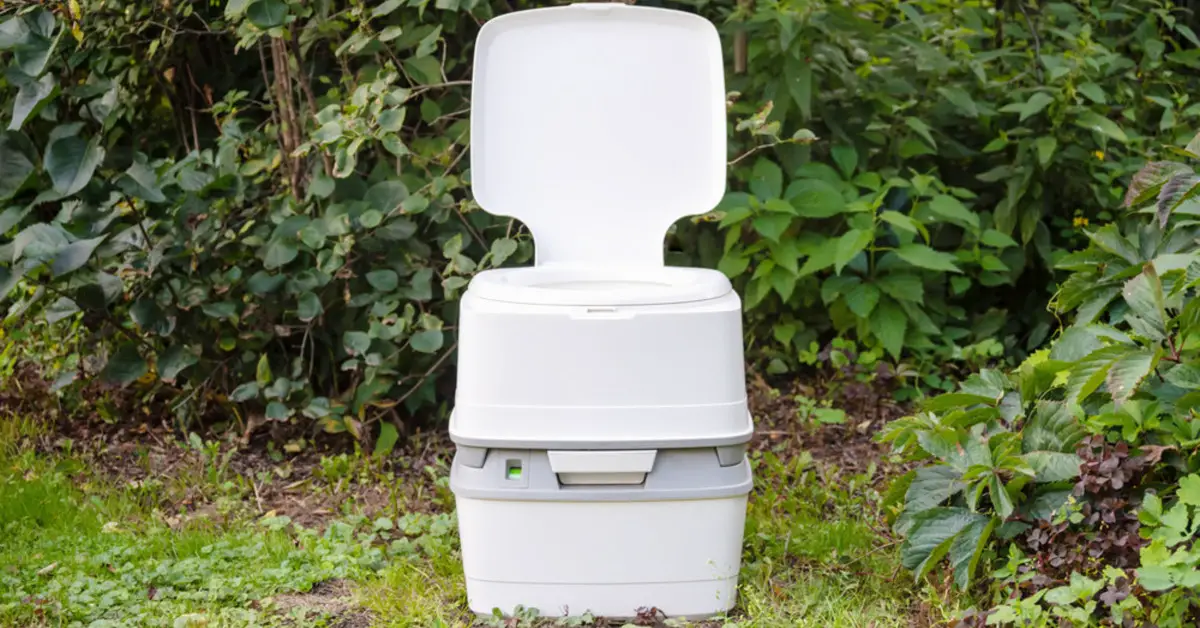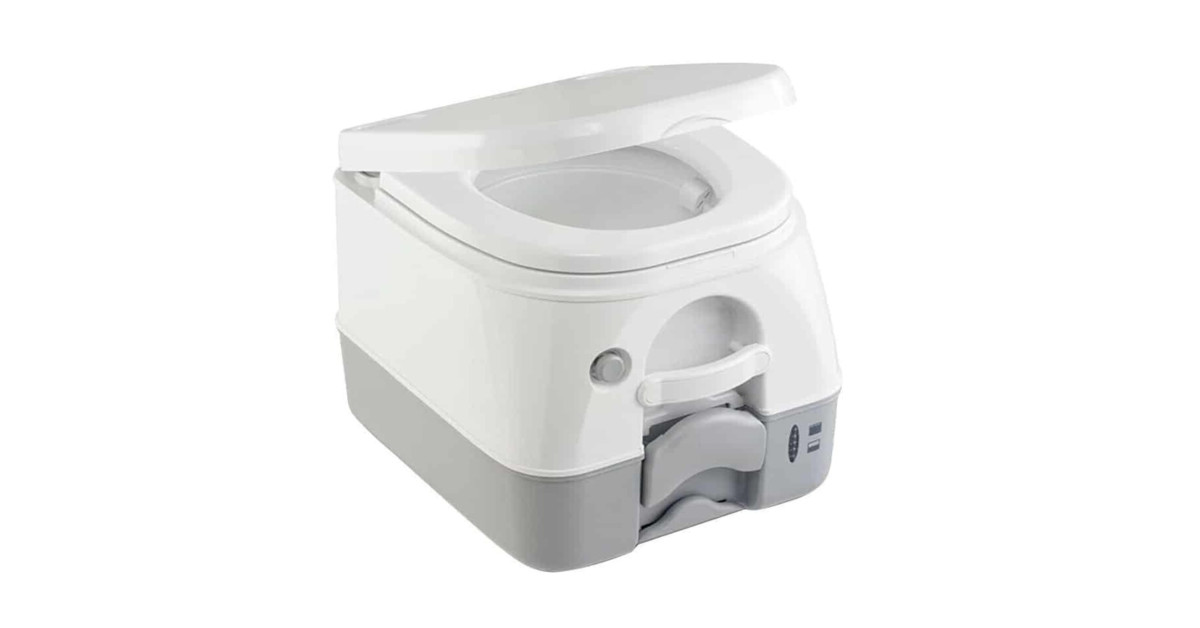
A portable camping toilet is one of the more important pieces of equipment you will need if you do any serious camping.
If you just want something to get you through a night or two occasionally, then you could get away with a folding toilet seat, or even just digging a hole.
Why do you need portable toilet?
If you ever plan to be away from toilet facilities for multiple nights, I strongly recommend you consider purchasing a chemical action portable camping toilet.
Even if the place you are staying does have toilets on site, sometimes they are so disgusting that having your own toilet seems like a better idea. We try and uncover the best camp toilet in this article, but here we are just going into detail on how portable toilets work.
Please note: In this article, we are focusing on chemical portable toilets, not composting toilets, or bag toilets, which are discussed in other articles.
Given the name ‘portable toilet’ can be used interchangeably, I just wanted to make that clear which type of portable toilet I am talking about here.
Portable toilets typically consist of a lid and a seat, which sit on top of two plastic tanks. The bottom tank (also known as a cassette), is the storage tank.
This is where your human waste is flushed from the toilet bowl. The toilet bowl is incorporated into the top tank (flush tank), and the whole purpose of the flush take, as the name suggests, is to flush the waste from the toilet bowl down into the storage tank.
They are sometimes referred to as chemical toilets, as some chemical additives are required to treat the waste in the bottom tank.
Portable toilets are the most robust and strong feeling portable camping toilets you can find. The plastic body, filled with liters of water and waste, sits very securely, and the sitting experience is comparable to that of a household toilet.

How Does A Portable Toilet Work?
Portable toilets provide a safe and comfortable way for you to do your wee and poo, when away from established toilet facilities, and store and transport it for appropriate disposal at a later time.
You use a portable toilet in much the same way as you would a normal toilet in that you sit down, deposit your waste, and then flush the toilet. However, the way the waste is managed and treated is very different.
Once you have finished doing your ‘business,’ you flush your portable toilet. This sprays water out from a jet at the top of the toilet bowl to wash the waste into the bottom storage tank.
In the bottom tank, the waste is exposed to chemicals (mixed with water) that help break down the waste and the gas, help minimize the odor, and store it in a safe way.
Once the bottom tank is getting full or your camping trip is over, you can empty your cassette (bottom tank), and rinse it out. If the chemical in the bottom tank did its job properly, then you should be able to pour out the waste contents without any blockage or residue and clean it very easily.
The appropriate place to empty your storage tank will depend on the chemicals you were using with it, as some are biodegradable and some are not. The different chemical options will be discussed later in more detail.
>> Check latest BCF pricing and reviews
How To Flush A Portable Toilet
All portable toilets have the ability to flush, but there are two different types of flushing mechanisms. The Piston flush, or the Bellow flush. The bellow flush mechanism is like a big plastic button that you have to push down repeatedly.
The top tank relies on air pressure to push the water out into the bowl. So when you operate the flush mechanism, you are actually pressuring the tank.
The piston flush tends to be easier to operate, especially for kids and the elderly, but both mechanisms work quite well.
Tank Capacity
Portable toilets differ in their tank capacity, both in the top water tank, and the bottom waste storage tank.
For example, the Thetford Porta Potti 365, has a 21-liter holding tank (waste), and a 15-liter water tank (flushing).
In contrast, the Dometic 976 portable toilet, which sells for nearly the same price, has an 18.9-liter holding tank, and 8.7-litre flush tank.
Emptying A Portable Toilet
Once the bottom storage tank is full, it will need emptying to avoid overflowing up into the bowl area. The thought of emptying the bottom tank is much scarier than it sounds.
Portable toilets are designed to be as easy to use as possible, so they have been engineered to be emptied easily, quickly, and cleanly.
The first step is separating the flushing tank from the storage tank. This can then be transported to the waste disposal location. If you are in a caravan park, there should be a waste disposal point.
Once you have taken your unit to your disposal point, twist the waste pipe away from the tank, and open the pressure release valve, and pour it into the disposal point.
Once you have emptied the contents, it is a good idea to rinse them out with water. The chemicals usually work quite well in breaking down human waste, and it pours out quite easily. However, a good rinse out each time is still a good idea.
Once the rinse is completed, you can reassemble the unit and prepare it for use again. To do this, you need to fill the bottom tank with three liters of water, and the required chemical additive.
Portable Toilet Chemicals
There is a range of chemicals available for use in your chemical toilet. Some are necessary, and others are optional. I’ll go through the different types here quickly.
Top (Flush) Tank
You don’t have to have any chemicals in the top tank. However, most people use a ‘pink’ colored chemical.
This chemical adds a nice fragrance to the unit, prevents the build-up of residue, also helps keep the seals and surfaces lubricated.
Bottom (Storage) Tank
You definitely need chemicals in the bottom tank, as this is where the waste is diverted and stored.
The chemical in the bottom tank is designed to break the waste down, and break down the gas, and improve the odor. There are two different varieties of storage tank chemicals, often distinguished by their colors.
Blue chemicals are the most effective and can be left in the tank for a longer period of time, but they are not biodegradable, so they cannot be disposed into your home septic tank, and buried in nature.
Whereas the green bottom tank chemical is a biodegradable version. This biodegradable version can be deposited into your home septic system, and can also be emptied in nature.
The downside of the green chemical is that it requires more regular changeover in the tank. So even if your tank is not full, you will still need to rotate the mix every 3-4 days.
Other chemicals you can consider using are Cassette Cleaner, Bowl Cleaner, and Tank Freshener.
These chemicals are specially designed for portable toilets because the nature of the plastic and rubber inside these toilets means you cannot just use any cleaning chemicals.
Some of the domestic chemicals may cause damage to the unit, so please use only the proper products to avoid damage.
Maintenance Of Your Portable Toilet
The best practice for maintenance of your portable toilet is a regular wipe down with a cloth, using mild detergent. It is important that you not use a sharp object, or petroleum-based chemicals when cleaning your unit, due to the risk of damage.
Things You Will Need With Your Toilet
Privacy Tent
If you are taking your own toilet, then you might need your own toilet enclosure as well. This is best achieved with a privacy tent, These.
Biodegradable Toilet Paper
Though you can flush toilet paper into your portable toilet, make sure to use ‘soft’ toilet paper.
Though more expensive, soft toilet paper is designed to break down a lot quicker and will prevent the risk of blockage in your unit.
Summary
Portable toilets are a great way to meet the toileting needs of your campers in a safe, comfortable, and hygienic way.
However, they do take up a lot of space and require regular maintenance, so you need to be prepared to do the work.
>> Check latest BCF pricing and reviews
Frequently Asked Questions
How Do You Know When a Portable Toilet Is Full?
With many portable toilets, you need to check visually by staring down through the drain hole.
But some of the more expensive units do have a gauge on the front that indicates the level inside the tank.
Can You Use A Portable Toilet In The Snow?
No. At freezing temperature, the water in the tanks will freeze and prevent it from operating in an intended manner. You will need an alternative camping toilet chair solution for freezing temperatures.
Can You Poo in a Camping Toilet?
Absolutely. They are designed to handle everything. In fact, if the males in your camp can do more of their wees in another location, you will get a longer life out of your storage tank as it will not fill up so quickly.